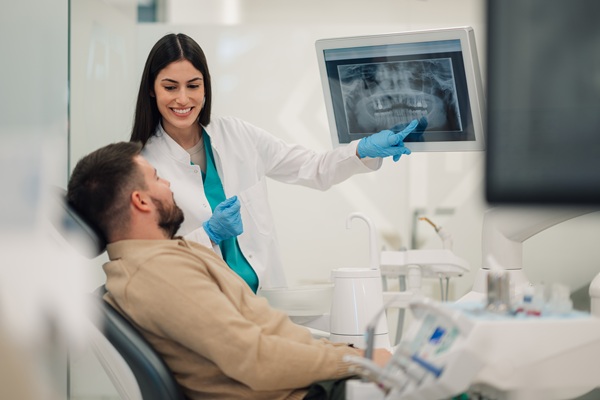What a Dental Exam Entails

Undergoing a dental exam at least twice a year is important for patients of all ages. A lot of oral health problems go unnoticed because they are symptomless or the signs are so minuscule that only a professional can identify them. Because of this, it is essential to visit a general dentist to undergo dental exams, which usually include a physical examination, as well as x-rays.
A review of what happens during a dental exam
Outlined below are a few things that typically occur during a dental exam. This information may be helpful to individuals who are preparing for an upcoming appointment.
Physical examination
Most people will experience the dentist feeling around their oral cavity during a dental exam. It is important for the dentist to physically check the soft tissues of the mouth to make sure there are no abnormalities that could indicate a problem. Additionally, physically checking the mouth helps to identify any oral cancer signs, an important step in dental exams for older patients especially.
Dental tool examination
A dental exam mainly involves the use of dental instruments or tools. Because the underside of the teeth is not easy to look at directly, the general dentist must use a tool that has a round mirror on the end. This tool does not induce pain, but rather gives the dentist a chance to see all sides and angles of the teeth and gums. The dentist will use this tool to thoroughly examine the oral cavity, checking for infections or abnormalities.
X-rays
Another part of a dental exam is the x-rays. X-rays are a very useful resource that general dentists rely on in order to see the mouth from a different angle. They give a view of the bone beneath the teeth, as well as the position of the jaw. Additionally, x-rays help identify problems between teeth, which are difficult to see with the normal eye.
While x-rays can be a cause of concern for some, it is important to know that the exposure to radiation is so minimal that there are little to no risks. Pregnant women should consult with the dentist beforehand as they are more at risk.
Cleaning and fluoride
Another part of a dental exam is the cleaning and fluoride application. Most dental examinations include this part, which is done twice a year or every six months. In the event that the dental exam is for a specific issue and it is not routine then the teeth are not likely to be cleaned.
Find out more from a general dentist
When looking for more information on what to expect from a dental exam, it is best to reach out to a general dentist. Any questions or concerns can be properly addressed. Additionally, the general dentist can provide specific details on the exam, which can be helpful in easing anxieties or fears about the appointment. Reach out today to learn more or to get scheduled for an appointment.
Request an appointment here: https://www.yanasedds.com or call Yanase Dental Group at (310) 736-1063 for an appointment in our Torrance office.
Check out what others are saying about our dental services on Yelp: Dental Exam in Torrance, CA.
Recent Posts
Gum disease is not a condition you should ever ignore. At the first signs of trouble, you should talk to your dentist about how to treat these issues and restore your gums to good health. While the dentist can recommend in-office treatment, there are also things you can do on your own. Along with good…
Enhancing the appearance of your smile is an important aspect of dental care, and cosmetic dentistry offers a variety of procedures to improve the aesthetics of teeth. Whether addressing discoloration, misalignment, or missing teeth, cosmetic dentistry provides tailored solutions that combine function and beauty. Understanding the most popular procedures in this field can help patients…
Preventive dentistry, including routine dental cleanings, is an essential part of having a healthy mouth. These dental visits help patients avoid cavities, enamel wear, and gum disease. As a result, regular dental cleanings are crucial to a dental patient's oral health.Signing up for a dental cleaning on a regular basis is something that every dental…
When a tooth develops a cavity, a tooth filling will be required to repair the tooth and restore its function and appearance. Since tooth pain is often the first sign of a cavity, it is normal for patients to be worried about what they will feel during the filling procedure. This article focuses on what…


